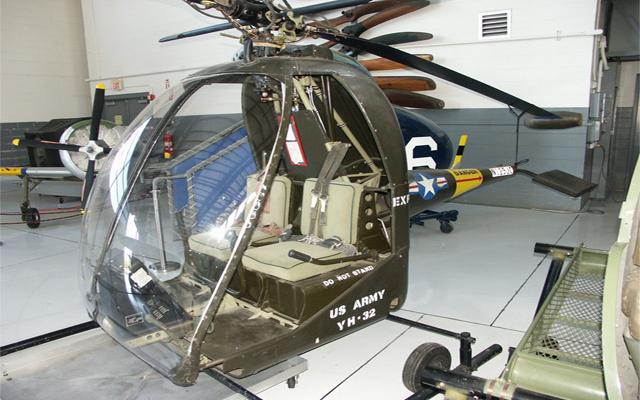
1956 Hiller Hornet
Built in the 1950s as a small artillery spotter, the Hornet used Ramjet engines to power the rotor blades. Among its design requirements was that it must require only minimum maintenance and could be transported by trailer.
Ramjet engines have no moving parts and develop their thrust from the expansion of the burning fuel; therefore, they are very simple.
The Hornet was not designed to stay in the air very long; it goes through its 45 gallon fuel capacity in about 25 minutes. The high fuel consumption was acceptable in exchange for simplicity of maintenance in the field. However, one drawback of operating the Hornet in combat conditions was that the engines proved to be extremely loud and gave off a fiery glow that could be seen at night. It would not have gone unnoticed by an enemy!
Another drawback was that if the engines should quit, the drag of the engines on the rotor-tips made it difficult to maintain rotor speed to make an emergency landing. Helicopters can safely “auto-rotate” down by maintaining forward speed in a steep glide. This maintains the blade inertia so that the helicopter can safely land. Because of the additional drag with the engines at the rotor tips, the blade angle must be lowered to a NEGATIVE ANGLE to keep the blades spinning, effectively creating a VERY fast descent rate. No pilot ever survived an auto-rotation that started above 100 feet! After 17 aircraft built, production was stopped.
Specifications
- Year Built — 1956
- Rotor Diameter — 23′
- Cruise Speed — 69 mph
- Gross Weight — 1,080 lbs
- Engine — Two Ramjets (31 lbs thrust each)
Kermit’s Comments
This Hornet was rebuilt and purchased in Oklahoma from Jack Canon. It was the 13th of the 17 aircraft built and is currently the only flyable example. When it was delivered, Mr. Canon did a quick demonstration flight. It is a real show to watch the whole operation from starting it, hearing it, and watching it fly. It takes more power to hover in a helicopter than what is required for flight. The hover performance of the Hornet is not that great with the weight of two people on board, but it is not a problem to fly with two people.
Because of noise complaints from our neighbors across the lake and over a mile and a half away, we have not flown it since. Just about any liquid that burns could be used for fuel such as gasoline, kerosene, or Jack Daniels. “If it’ll burn, it’ll turn!”